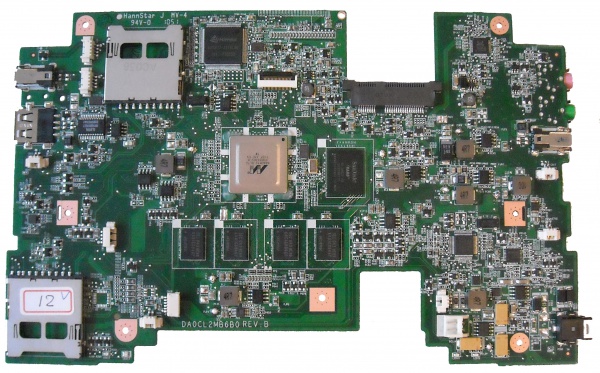XO 1.75 A2: Difference between revisions
| Line 81: | Line 81: | ||
'''By default, the eMMC device is selected''' |
'''By default, the eMMC device is selected''' |
||
On some laptops, a blue wire may tie R342 to pin 10 of CN21 (the internal SD slot) or TP117. If an internal SD card is present on these laptops, it will be used. On these laptops, eMMC used if no card is inserted in the internal SD slot. |
On some laptops, a blue wire may tie (the non-grounded side of) R342 to pin 10 of CN21 (the internal SD slot) or TP117. If an internal SD card is present on these laptops, it will be used. On these laptops, eMMC used if no card is inserted in the internal SD slot. |
||
== Documentation == |
== Documentation == |
||
Revision as of 05:35, 9 January 2011
XO-1.75 Laptop Alpha test model 2, also known as A-test or A2.
Description
The A2 are the second prototypes of the XO-1.75 built. They use the larger pitch (0.65 mm) version of the Marvell Armada 610 SOC, change the board outline to match that of XO-1.5, and support either an internal eMMC chip or a full-sized SD card.
The number of boards obtained will be small, and distribution will be limited to hardware testing and OFW and Linux kernel driver development.
Identification
- Bare circuit board, no case or display
Photographs:
Software Support
XO-1.75 use Q4xxx firmware releases. These will not work on an XO-1 or XO-1.5. For the first time, Open Firmware is provided as part of the Linux image, and the EC firmware is separate. The current firmware release for A2 is Q4A11.
It is strongly recommended that you have two sources of power (a charged battery and an external power source) when you upgrade your EC or Open Firmware. Failure to do so may require the use of an SPI programmer to recover your laptop.
Upgrading OFW
Place a recent release of the Q4XYY firmware onto an SD device, and place it in the external SD slot.
Interrupt the OFW boot process by pressing the ESC key.
Type (assuming a q4a11 release):
flash ext:\q4a11.rom
Reboot by holding down the power button once this is completed.
Upgrading the EC code
This is currently being debugged. The reliable way of upgrading the EC code involves in-circuit reprogramming of the EC SPI Flash ROM using an SPI programmer.
The ultimate goal is reprogramming via the host/EC EDI (ENE Debug interface) interface.
Upgrading Linux
A Linux image for the A2 is available at http://build.laptop.org/F12-arm/os1/.
Installing from OpenFirmware
You will need the .zd version of the OS image. Download it, then:
- Place the image on an SD card, and insert it into the XO-1.75 laptop's external SD slot.
- Get the Ok prompt,
- Install onto the internal SD card, type:
fs-update ext:\os1.zd
Installing from Linux using an XO-1.5
To install on an XO-1.5, boot an XO-1.5 to Linux, insert the SD card in the XO-1.5 external slot, then:
zcat os1.img.gz > /dev/mmcblk1
... and then power down, remove the SD card, and insert in the XO-1.75.
Installing from OpenFirmware using an XO-1.5
You will need the .zd version of the OS image. Download it, then:
- Place the image on a USB stick, and insert it into the XO-1.5 laptop's USB port.
- Get the Ok prompt,
- To install onto the internal SD card, type:
fs-update u:\os1.zd
To install an image onto the external SD card, you need to type:
devalias fsdisk ext:0 fs-update u:\os1.zd
... and then power down, remove the SD card, and insert it in the XO-1.75.
Restrictions
There is a list of recommended modifications (ECOs).
Selecting the internal SD
Only one of the internal SD slot and the eMMC may be used at any time. Which will be used is selected by a jumper (R342). If R342 is shorted (or R341 is depopulated and R342 populated), the internal SD card is selected. If R342 is depopulated, the eMMC device is selected.
By default, the eMMC device is selected
On some laptops, a blue wire may tie (the non-grounded side of) R342 to pin 10 of CN21 (the internal SD slot) or TP117. If an internal SD card is present on these laptops, it will be used. On these laptops, eMMC used if no card is inserted in the internal SD slot.
Documentation
Supporting documentation for these boards (all in PDF, Not updated for A2 yet):
Please note that production boards will likely have different pin mappings and connector locations.

